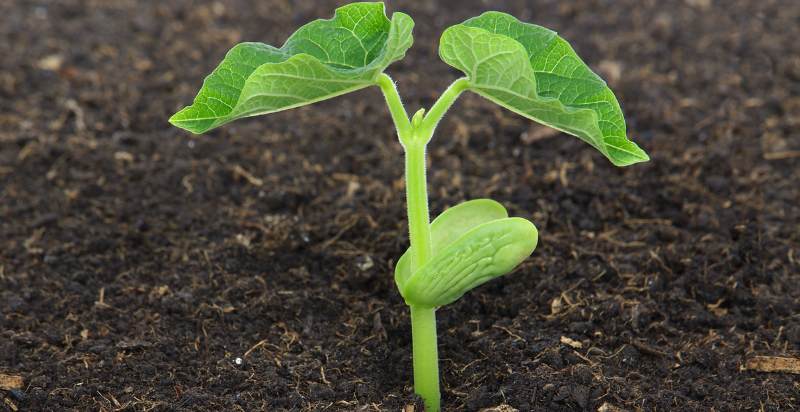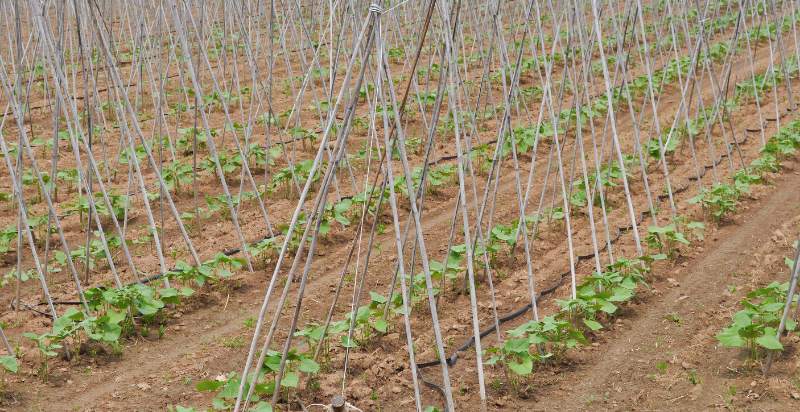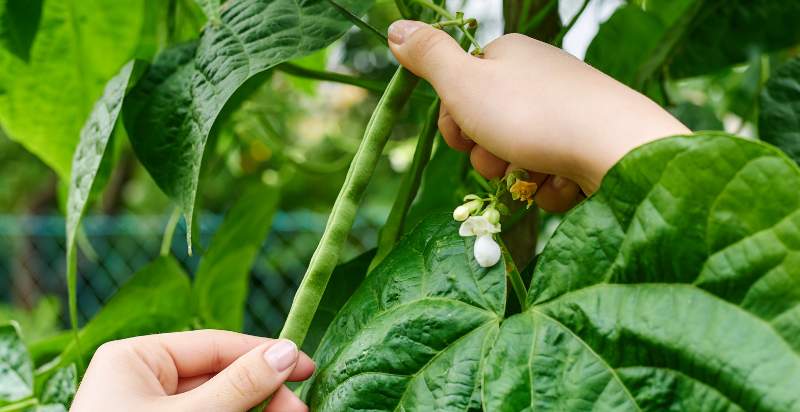Do you like delicious, home-cooked beans? The humble bean (Phaseolus vulgaris) is a nutritional powerhouse packed in protein, fiber, vitamins, and minerals. All for very few calories. And they’re not just great for your health; beans may also help the environment. A staple food in cuisines worldwide, beans are inexpensive, tasty, and easy to prepare.
If you’re interested in learning how to plant, grow, and care for common beans, you’ve come to the right place! Beans are a great addition to any garden and are fairly easy to grow.
This blog post will teach you everything you need to know about growing these versatile plants. So read on and get started today!
What Are Beans?
Beans are part of the legume family, including peas and lentils. Legumes are plants that grow in pods, and all three of these types of legumes are categorized as pulses. The edible seeds of plants in the legume family are known as pulses.
There are more than 40,000 varieties of beans in existence, but the ones you’re most likely to find at your local grocery store include the following:
- Black beans
- Pinto beans
- Kidney beans
- Navy beans
- Lima beans
- Chickpeas (also called garbanzo beans)
- Green peas
While all of these varieties have different shapes, sizes, and colors, they all have one thing in common: They’re incredibly healthy. Beans are so good for you that they’ve been dubbed a “superfood.”
Description Of Beans:
The common bean is a highly variable plant with a long history. Its wild ancestor is thought to have originated in Peru, where it was cultivated for about 7,000 years before being completely domesticated around 2,000 BCE. From there, it spread throughout the Americas and to Europe and Africa. Today, They are an important part of the diets of people all over the world.
There are more than 500 common bean varieties, divided into two subspecies: Phaseolus vulgaris var. Vulgaris, which includes most dry beans, and Phaseolus vulgaris var. nanus, which includes black beans and pintos. They can be either bush or pole varieties. Bush varieties reach about 2 feet (0.6 meters), while pole varieties can grow up to 10 feet (3 meters).
The common bean is an annual plant with a lifespan of just one growing season. It has a taproot, which anchors the plant in the soil, and fibrous lateral roots, which help to hold the soil together and absorb water and nutrients. The stem of the common bean is green and hairless, and the leaves are arranged alternately along the stem in pairs. Each leaf has three oval-shaped leaflets.
The flowers of the common bean are white or purple and grow in clusters at the ends of the stems. The plant’s fruit is a pod that contains anywhere from one to 12 beans. Common beans can be black, white, red, pink, green, or brown, depending on the variety.
Cultivation Of Beans:
Common beans are farmed in tropical and subtropical areas throughout the world. America comes in third place behind Brazil and India as the world’s top producer of common beans. Other major producers include China, Mexico, and Ethiopia.
In the United States, They are mostly grown in the Midwest, with significant production in Ohio, Michigan, Iowa, Nebraska, and Minnesota. California is also a major producer of dry beans.
After the final frost has passed, beans are normally planted in the early spring. They can be planted directly in the ground or started indoors in pots and then transplanted outdoors once they’ve outgrown their pots.
Health Benefits of Beans:
Beans are an excellent protein source, essential for cell growth, tissue repair, and the production of enzymes and hormones. For example, a 1-cup serving of black beans provides 15 grams of protein.
They include a lot of fiber and are a fantastic source of protein. Fiber encourages regularity, aids in sugar regulation in the body, and may lower the risk of heart disease and other illnesses. Black beans have 15 grams of fiber in a serving size of 1 cup.
Regarding vitamins and minerals, beans are a great source of iron, potassium, magnesium, copper, manganese, thiamine (vitamin B1), and vitamin B6. Just 1 cup of black beans provides 35% of the daily value for iron and 60% of the DV for thiamine.
An essential electrolyte that helps control heart and blood pressure function is potassium. At the same time, magnesium participates in more than 300 biochemical processes that control blood sugar, blood pressure, and muscle and nerve function.
So beans are a great option if you’re looking for a wholesome, nutrient-dense diet that can aid in weight loss and health improvement.
Uses of Beans:
Beans can be used in a variety of dishes, both sweet and savory. Common varieties include black, red kidney, white, and pinto beans.
Black beans are often used in Cuban and Mexican dishes, such as rice and beans, black bean soup, and black bean enchiladas.
In chili and other hearty stews, red kidney beans are frequently used. Pinto beans are typically used in refried beans and other dishes with a Mexican influence, whereas white beans are frequently used in soups and salads.
Regardless of the variety of beans, they’re versatile ingredients that can be used in various recipes. So if you’re looking for a healthy, delicious, and versatile ingredient to add to your kitchen pantry, beans are a great choice.
How to Plant, Grow, and Care for Common Beans?
If you’re looking for an easy-to-grow, nutritious, and versatile vegetable to add to your garden, look no further than common beans. Common beans (Phaseolus vulgaris) are legumes that include popular varieties such as black beans, kidney beans, navy beans, and pinto beans.
They can be used in various sweet and savory meals and are a wonderful source of protein, fiber, vitamins, and minerals. You can get all the information you need to plant, grow, and care for common beans right here.

When to Plant
Common beans should be planted as soon as the last frost has passed and the soil has warmed to at least 60 degrees Fahrenheit. They can be planted immediately in the garden or started indoors before being transplanted.
If you’re starting your beans indoors, plant them about six weeks before the last frost. Place two or three seeds per cell in a seed-starting tray filled with potting soil. Keep the soil moist but not soggy, and put the tray somewhere warm and sunny.
The seeds will germinate in five to 10 days. Once they’ve sprouted, thin out the seedlings so that only the strongest one remains in each cell.
About two weeks before you transplant your seedlings outdoors, acclimate them to the outdoors by gradually increasing their exposure to sunlight and wind. Place them outside for a short period each day in a protected area, then gradually extend their time outside until they can stay outside without suffering any negative effects.
Handle your seedlings carefully while transplanting them to prevent breaking the flimsy roots. They should be planted at the same depth as in the tray and given plenty of water.
If you’re planting your beans in the ground, space the seeds 4 inches apart and 1 to 2 inches deep in rows 24 to 36 inches apart. After they have sprouted, thin the seedlings every 6 to 8 inches so that only the strongest ones are left.

Soil, Sun, and Water Requirements
Common beans prefer well-drained soil with a pH of 6.0 to 7.0. They also need full sun to produce the best yields, so plant them in an area with at least six hours of direct sunlight daily.
As far as water requirements go, beans need about 1 inch per week. However, they’re relatively drought-tolerant and can survive on less water during dry periods. Just be sure to water them deeply and regularly during the first few weeks after planting so their roots can establish themselves properly.
Fertilizing Requirements
Legumes like beans can fix nitrogen from the air into the soil. This makes them relatively low-maintenance when it comes to fertilizing; in most cases, they won’t need any additional fertilizer beyond what’s already in the soil.
However, if you’re planting your beans in particularly poor soil or you want to give them a little boost, you can side-dress them with compost or a general-purpose fertilizer once they start to flower. Stay moderate because too much fertilizer can prevent beans from producing.
Pests and Diseases
Common beans are relatively resistant to pests and diseases, but there are a few that you should be on the lookout for, including bean mosaic virus, anthracnose, and common rust.
To prevent these problems, start with disease-free seeds and water your plants at the base rather than from above to avoid wetting the foliage. You can also use a fungicide to treat your plants if you see any disease symptoms.
As for pests, common bean pests include aphids, bean beetles, leafhoppers, and Mexican bean beetles. The best way to deal with these pests is to hand-pick them off your plants and destroy them. You can also treat your plants with an insecticide if the problem is particularly bad.
Harvesting Common Beans
Common beans are typically ready to harvest about 60 to 90 days after planting, though this will vary depending on the variety. The best way to tell if they’re ready is to pop one open and taste it; the beans should be tender but firm.
To harvest your beans, snap them off the plant at the stem. You can eat them fresh or cook them like any other type of bean.

How To Store Homegrown Beans?
Beans are best used fresh but can also be stored later. To store them, place the beans in a moisture-proof container and keep them in the refrigerator for up to a week. You can also freeze them for longer-term storage; blanch them first to retain their flavor and texture.
Common Beans in the Kitchen:
When it comes to using ordinary beans in cooking, the options are virtually unlimited. They can be boiled and served on their own or used in salads, casseroles, soups, and stews. You can also use them as a replacement for meat in many recipes; for example, try using cooked beans instead of ground beef in tacos or chili.
One of the great things about common beans is that they’re so versatile; they can be used in sweet and savory dishes. For example, add them to a fruit salad or use them in a dessert like black bean brownies. The possibilities are endless.
Risks:
Common beans are generally safe to eat, but there are a few things to remember. First, if you have a history of kidney stones, you should limit your intake of beans as they contain high levels of oxalates, which can aggravate the condition.
Additionally, some people may experience gas or bloating after eating beans due to their high fiber content, which is perfectly normal. If the problem is particularly bad, try soaking the beans overnight before cooking them. This will help reduce the amount of gas-producing sugars released into the gut.
Conclusion:
Common beans are a delicious and nutritious addition to any diet. They’re relatively easy to grow and can be used in various sweet and savory dishes. If you have a history of kidney stones, limit your intake. If you have gas or bloating issues, soak the beans overnight.
- Everything You Wanted to Know About Red Tamarillos - June 2, 2025
- A Guide to Tulips: Everything You Need to Know & More… - June 2, 2025
- Guanabana: Description, Flavor, Benefits, And Uses - May 27, 2025

12 thoughts on “Beans Plant: How to Plant, Grow, and Care for Common Beans. ”
Comments are closed.